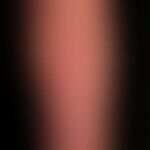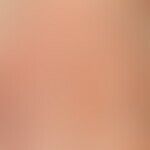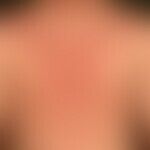Synonym(s)
HistoryThis section has been translated automatically.
MacMillian, 1973; Tan, 1974; Beylot, 1980
DefinitionThis section has been translated automatically.
Acute, generalized, mostly febrile, non-follicular, sterile, pustular (subcorneal pustule) exanthema, which occurs in connection with infections and/or medication, but also spontaneously, and which is always accompanied by marked systemic leukocytosis and neutrophilia and has a strong tendency to heal spontaneously.
You might also be interested in
Occurrence/EpidemiologyThis section has been translated automatically.
The incidences are given as 0.1-0.5/100,000 inhabitants/year.
Women seem to be affected slightly more often than men.
EtiopathogenesisThis section has been translated automatically.
Occurs in > 90% of cases after taking medication. Triggers described include:
- Frequently:
- Antibiotics:
- β-lactams and β-lactamase inhibitors: oxacillin, dicloxacillin, amoxicillin ± clavulanic acid, piperacillin-tazobactam and faropenem.
Cephalosporins: cefixime, ceftriaxone, cefepime and cefotaxime.
Macrolides: Azithromycin
-
Fluoroquinolones: ciprofloxacin and tosufloxacin
Antibiotics of different classes: clindamycin, tigecycline, telavancin, trimethoprim-sulfamethoxazole, vancomycin, daptomycin, metronidazole and pristinamycin.
- Antimalarials: Hydroxychloroquine is the second most frequently reported drug after antibiotics overall (Catho G et al. 2013). Especially in the era of the coronavirus pandemic 2019 (COVID-19) of 2020, there have been increased reports of hydroxychloroquine-induced AGEP, which may be due to the increased use of the drug (see also Generalized pustular figured erythema). It is noteworthy that AGEP triggered by hydroxychloroquine is usually delayed in onset due to the long half-life of 40-50 days compared to other drugs. Other antimalarials that can induce AGEP are: atovaquone/proguanil.
- Antifungals such as terbinafine, fluconazole, miconazole gel and nystatin
- Antivirals: acyclovir, favipiravir, remdesivir and ritonavir
- Calcium channel blockers (diltiazem)
- Antibiotics:
- Less frequently:
- Allopurinol
- carbamazepine
- Glucocorticoids
- ibuprofen
- metamizole
- Oxicame
- Pseudeoephedrine (in flu remedies)
- Paracetamol
- Chemotherapeutic agents: bendamustine, docetaxel, doxorubicin, gemcitabine, mycophenolate mofetil and paclitaxel
- Biological tumor therapeutics: cetuximab, erlotinib, rituximab, sorafenib and vismodegib
- Immunotherapeutics: pembrolizumab, ipilimumab, nivolumab, atezolizumab and IL-2.
Generalized subcorneal pustulosis can also be a partial symptom of genetic inflammatory systemic diseases (see below DIRA - mutation in the IL1RN gene). An association with HLA-B5, -DR11 and -DQ3 is observed.
Infections: Several infections have been reported in connection with the occurrence of AGEP. Reports of AGEP after Chlamydia pneumoniae, Mycoplasma pneumoniae, coccidiomycosis, COVID-19, cytomegalovirus (CMV), Epstein-Barr virus (EBV) and parvovirus B19 are available. It is conceivable that patients with an underlying infectious disease are more susceptible to developing AGEP. It is also conceivable that patients with an underlying infectious disease may develop AGEP as a consequence of pharmacologic treatment to treat the infection.
Vaccinations: There are reports of AGEP following influenza vaccination and Spikevax COVID-19 vaccination /Moderna (Hayashi E et al. 2021; Agaronov A et al. 2021; Mitri F et al. 2021). The pathogenesis could also be due to the "cytokine storm-like" global immune activation that can occur, for example, after COVID-19 infection or vaccination. Given the high frequency of influenza vaccination and mRNA COVID-19 vaccination internationally, it can be concluded that the epidemiological risk of contracting AGEP is very low.
PathophysiologyThis section has been translated automatically.
Several immunological pathways are involved in the pathogenesis of AGEP. They all lead to an increased secretion of interleukin (IL)-8 and the subsequent migration and survival of neutrophil granulocytes.
In principle, it can be assumed that AGEP is based on a T-cell-mediated delayed-type hypersensitivity reaction to a specific drug or other trigger. After exposure to the triggering agent, antigen-presenting cells(APCs) present the antigen on their surface using molecules of the major histocompatibility complex. This leads to the activation of CD4+ and CD8+ T cells, which react in a drug-specific manner.
Furthermore, activated T cells proliferate. They migrate into the dermis and epidermis. The drug-specific CD8+ T cells induce apoptosis of keratinocytes via perforin/granzymeB and Fas ligands. Histologically, this can be seen in the formation of epidermal vesicles (Baker H et al. 1968). In addition, activated T cells secrete IL-8, which is a chemoattractant for neutrophil granulocytes. This results in pustulation in the epithelial area and associated systemic neutrophilia (Sidoroff A et al. 2007).
- Note: There is no AGEP without neutrophilic leukocytosis!
In AGEP, T helper (Th) 1 cells predominate. This leads to increased secretion of interferon (IFN)-γ and granulocyte/macrophage colony-stimulating factor, which in turn promotes neutrophil survival. Th2 cells, which produce IL-5, may also play a role. This is particularly true in patients with associated eosinophilia . IL-5 is a strong eosinophil stimulator. Th17 lymphocytes also appear to play a role in the pathogenesis of AGEP, as the cytokines IL-17 and IL-22 produced by these cells synergistically promote downstream IL-8 secretion(Sidoroff A et al. (2007).
Genetic basis of AGEP: Mutations in the IL36RN gene, which codes for the IL-36 receptor antagonist, are more common in patients diagnosed with both AGEP and pustular psoriasis than in unaffected individuals (Sidoroff A et al. 2007; Meier-Schiesser B et al. 2019; Navarini AA et al. 2013; Song HS et al. 2016; Sugiura K 2014). Interleukin-36 is a proinflammatory cytokine secreted by macrophages and keratinocytes. IL-36 receptors are identified in AGEP in high concentrations on the surface of APCs in the skin. See also interleukin-36 receptor antagonist deficiency syndrome (DITRA). Typically, the IL-36 receptor antagonist blocks the signaling of inflammatory cytokines such as IL-36α, IL-36β and IL-36γ (Song HS et al. 2016). The gene encoding this receptor antagonist(IL36RN gene) is a small gene with six exons located on chromosome 2 at position q14. Dysregulation of this pathway (e.g. by the mutations detected in this gene) leads to increased IL-36 signaling and thus to increased production of the downstream cytokines IL-6, IL-8, IL-1α and IL-1β. It can be assumed that the increase in these signal transmissions predisposes to pustular eruptions (Baker H et al. 1968). It has been shown that amoxicillin and letrozole can specifically trigger the production of IL-36γ cytokines by sensitized CD14+ macrophages from peripheral blood via Toll-like receptor 4 and by keratinocytes in patients, respectively.
Of note are reports of overlap between AGEP and generalized pustular psoriasis (GPP). For example, one such constellation was reported in response to ceftriaxone, in which a patient with psoriasis vulgaris developed pustular exanthema after taking the antibiotic. However, it was not clear whether this was a case of AGEP in a patient with a history of psoriasis or an acute exacerbation of pustular psoriasis (Isom J et al. 2020; Vyas NS et al. 2019).
AGEP a polygenic disease: In a larger study (n=67 patients), the coding exons of IL36RN, CARD14 and AP1S3 were sequenced - 61 with GPP, two with acute generalized exanthematous pustulosis (AGEP) and four with acrodermatitis continua suppurativa (Hallopeau). The majority of patients (GPP/ 64 %) did not carry rare variants in any of the three genes. Biallelic and monoallelic IL36RN mutations were found in 15 (24%) and 5 (8%) patients with GPP, respectively. The only significant genotype-phenotype correlation observed in IL36RN mutation carriers was early age at disease onset. Additional rare CARD14 or AP1S3 variants were identified in 15% of IL36RN mutation carriers (Mössner R et al. 2018).
ManifestationThis section has been translated automatically.
A special age disposition does not exist. Children are less frequently affected than adults.
LocalizationThis section has been translated automatically.
Typical is the infestation of the large flexures (axillary, submammary, inguinal region); but generalized infestation is also possible. AGEP can be accompanied by oedema of the facial skin.
ClinicThis section has been translated automatically.
Onset of the disease with significant impairment of the general condition; often febrile course with temperatures > 38°C.
Typical onset is on the face and the large bends of the joints with disseminated, synchronized, relapsing, extensive erythema or red swellings on which multiple, constricted, non-follicular pustules about 0.1 cm in size form. These merge to form large lakes of pus, whereby the delicate pustule cover can be pushed away from its lower surface (Nikolski phenomenon) and lies on top like a crumpled damp cloth. The pustular exanthema is accompanied by itching or stinging or burning pain (needle-like).
In some cases, erythema exudativum multiforme-like cockade patterns may develop, in which the pustules are usually arranged towards the edges, either disseminated or in groups. The pustules persist for a few days; they heal with a shaggy, raised, keratolytic scaling (thin -carlatiniforme horn lamellae - see Fig.).
Involvement of mucous membranes close to the skin (oral mucosa, genitalia) can occur but is rather rare. If present, clinically mild exfoliating enanthema is more common.
Systemic involvement: Systemic involvement is any organ dysfunction that occurs together with the cutaneous symptoms and cannot be attributed to another cause or disease. Studies have shown that 17-20% of AGEP cases have internal organ involvement, most commonly liver, kidney or lung disease.
Liver: Liver findings are elevated enzyme levels that are either hepatocellular (elevated aspartate aminotransferase and alanine aminotransferase up to twice the normal value) or cholestatic (elevated alkaline phosphatase and γ-glutamyltransferase). Abdominal ultrasonography may show steatosis or hepatomegaly, both of which are non-specific.
Kidneys: Renal findings may include a creatinine >1.5 times baseline, indicating severe acute kidney injury.
Pulmonary: Pulmonary findings may include pleural effusions, hypoxemia and increased oxygen demand.
Systemic symptoms usually resolve with discontinuation of the causative drug, treatment of the underlying disease and supportive care. AGEP cases associated with systemic symptoms are usually associated with higher morbidity and mortality than AGEP cases with only cutaneous features.
Remember. Coarse lamellar corneolytic desquamation is diagnostically indicative of subcorneal pustulation!
In an atypical course, clinically evident pustule formation may be absent in this clinical picture. It is then only seen in the histological preparation; however, even in these cases a lesional corneolytic scaly ruff is found on healing.
DiagnosticsThis section has been translated automatically.
The literature reports positive patch test results in AGEP. Ninety-three drugs were identified in a larger study, which together caused 259 positive patch tests in 248 patients with AGEP. The following drug classes showed the most frequent reactions (de Groot AC 2022):
Beta-lactam antibiotics (25.9%)
other antibiotics (20.8 %)
contrast media containing iodine (7.3 %)
corticosteroids (5.4 %)
Together, these drugs account for almost 60% of all reactions
LaboratoryThis section has been translated automatically.
ESR elevation, CRP elevation, always marked leukocytosis (leukocytes > 10,000-12,000/mm³; sine qua non), marked neutrophilia, usually mild to marked relative lymphopenia, possibly eosinophilia. Not obligatory are elevations of transaminases and alk. phosphatase.
HistologyThis section has been translated automatically.
Exocytosis with intraepidermal, immediate subcorneal accumulations of neutrophil granulocytes.
Formation of spongiform to unicompartmental (nonfollicular)pustules.
Focal loss of str. granulosum. Mostly orthokeratotic epithelium. Occasionally, admixtures of eosinophilic granulocytes and erythrocyte extravasations are also present.
Pattern: Superficial perivascular and diffuse neutrophilic dermatitis with subcorneal pustule formation.
In contrast to TEN (subepidermal cleft formation with necrotic epidermis), biopsy in pustulosis acuta generalisata shows subcorneal pustules.
Direct ImmunofluorescenceThis section has been translated automatically.
Immunohistology: Immunoglobulins (IgG) and complement factors (C3) in the vessel walls of the capillaries of the stratum papillare and in the basement membrane zone
DiagnosisThis section has been translated automatically.
The "AGEP validation score" of the EuroSCAR study group (Sidoroff et al. 2001) is helpful for validating the diagnosis. A score of 8-12 points speaks for the diagnosis:
AGEP validation score of EuroSCAR study group (Sidoroff A et al. 2001)
Symptom Score
- Pustule
- Typical +2
- Compatible +1
- Not compatible 0
- Erythema
- Typical +2
- Compatible +1
- Non-compatible 0
- Distribution pattern
- Typical +2
- Compatible +1
- Non-compatible 0
- Postpustular desquamation
- Typical +1
- Non-compatible 0
- Mucosal infestation
- Yes +1
- No 0
- Acute course (<10 days)
- Yes +1
- No 0
- Healing (<15 days)
- Yes +1
- No 0
- Fever
- Yes +1
- No 0
- Neutrophilic leukocytosis (>7,000)
- Yes +1
- No 0
Differential diagnosisThis section has been translated automatically.
- Clinical differential diagnoses:
- Pyoderma (microbiological detection of the purulent cocci)
- Psoriasis pustulosa generalisata (anamnesis; chronic recurrent course, recurrences without fever symptoms and without the severe general symptoms of AGEP)
- Dermatosis, acute febrile neutrophils (Sweet-Syndrome) (analogous acute and general symptoms, but primarily reddish-livid, succulent papules, nodules and plaques. Intralesional, grafting pustular formation possible. Pustules, however, not in the density as in AGEP.
- Hand-foot-mouth disease (few acral localized painful blisters; only moderate or no disturbance of the AZ)
- Erythema exsudativum multiforme (not pustular)
- Lyell syndrome (large-area exfoliative, not pustular)
- Subcorneal pustulose (chronic recurrent course; similar clinical morphology! The occurrence of larger and flaccid pustules - hypopyon formation is indicated). Entity is increasingly disputed!
- Impetigo herpetiformis (occurrence in the last trimester of pregnancy)
- Pityrosporum folliculitis (always follicular papules and pustules; no severe course of the disease).
- Histological differential diagnoses:
- Psoriasis pustulosa generalisata (no reliable histological differentiation; medical history)
- Pustular tinea (subcorneal pustular formation possible; detection of hyphae in the PAS preparation; in the upper dermis dense diffuse, sometimes perivasally accentuated lymphocytic infiltrate with few neutrophils and eosinophil granulocytes)
- Impetigo contagiosa (subcorneal pustule; detection of bacteria)
- Impetiginized eczema (eczema picture with broad-based acanthosis and extensive parakeratosis, broad spongiosis; focal penetration of the epithelium with neutrophil granulocytes).
General therapyThis section has been translated automatically.
Stopping the triggering medication.
External therapyThis section has been translated automatically.
Internal therapyThis section has been translated automatically.
Healing is usually described 10-14 days after discontinuation of the triggering drug. Until then symptomatic therapy, e.g. with dimetindene or other H1-blockers.
Important: control of protein and electrolyte balance.
Internal steroid medication can be initiated in the eruption phase of the disease: Initially 250-150 mg prednisolone/day i.v.; reduce by 50 mg daily depending on the acuity, oralize from 50 mg and reduce in 5 mg steps.
Progression/forecastThis section has been translated automatically.
Spontaneous healing after 10-28 days
Note(s)This section has been translated automatically.
The disease also heals spontaneously after discontinuation of the triggering medication. The extent to which glucocorticoid therapy is useful is currently unclear.
In individual cases, a positive epicutaneous test against the causative medication can be achieved after the clinical symptoms have subsided (the non-irritant concentration of the medication in epicutaneous testing of drugs varies).
Case report(s)This section has been translated automatically.
- Findings: Patients in clearly reduced, feverish (38.7 °C) AZ. On the trunk and extremities in diffuse distribution dense exanthema of 0.2-0.5 cm large, red, partly isolated papules and plaques, partly confluent to larger areas. Particularly on the confluent plaques, isolated pustules of barely 0.1 cm in size, which in places have confluated to form larger pus puddles, can hardly be seen. Oral mucosa o.B. No hepatosplenomegaly, no lymph node swelling.
- Histology: Intraepidermal, superficial, spongiform to single chambered pustules. Laboratory: CRP 65 mg/l; leucocytosis (16.400/µl), neutrophilia (87%), lymphopenia (1.200/ul), GGT(54 U/l).
- Therapy: Systemic glucocorticoids (prednisolone 250 mg/day i.v. with dose reduction of 50 mg in decreasing doses. Additional sedative antihistamine ( Dimetinden 2 times/day 4 mg i.v.). Local therapy with thin application of Lotio alba or Lotio alba aquosa skin-coloured (NRF 11.22.).
- Course: After 2 days of defibrillation, after 4 days of paling of the lesions, coarse lamellar desquamation first on the trunk and significantly later on the lower extremity. After 7 days CRP 35 mg/l, leucocytosis at 11,400 µ/l. After 14 days extensive restitutio. The patient was allowed to take lukewarm showers in each phase of the disease.
LiteratureThis section has been translated automatically.
- Beylot C et al. (1980) Acute generalized exanthematous pustulosis. Semin Cutan Med Surg 15: 244-249
- de Groot AC (2022). Results of patch testing in acute generalized exanthematous pustulosis (AGEP): A literature review. Contact Dermatitis 87:119-141.
- Langner D et al. (2011) Systemic therapy with infliximab in severe pustular generalized psoriasis and psoriatic arthritis. Act Dermatol 35: 185-186
- Lin JH et al. (2002) Acute generalized exanthematous pustulosis with erythema multiforme-like lesions. Eur J Dermatol 12: 475-478
- Macmillan AL (1973) Generalized pustular drug rash. Dermatologica 146: 285-291
- Mössner R et al. (2018) The genetic basis for most patients with pustular skin disease remains elusive. Br J Dermatol 178:740-748.
- Nigen S et al. (2003) Drug eruptions: approaching the diagnosis of drug-induced skin diseases. J Drugs Dermatol 2: 278-299
- Paulmann M, Mockenhaupt M (2015) Severe drug-induced skin reactions: clinic, diagnosis, etiology and therapy. JDDG 13: 625-643
- Pichler WJ et al. (2002) Cellular and molecular pathophysiology of cutaneous drug reactions. Am J Clin Dermatol 3: 229-238
- Rouchouse B et al (1986) Acute Generalized Exanthematous Pustular Dermatitis and Viral Infection. Dermatologica 173: 180-184
- Sidoroff A et al. (2001) Acute generalized exanthematous pustulosis (AGEP)--a clinical reaction pattern. J Cutan Pathol 28:113-119.
- Sidoroff A et al. (2007) Risk factors for acute generalized exanthematous pustulosis (AGEP) - results of a multinational case-control study (EuroSCAR). Br J Dermatol 157: 989-996
- Sidoroff A et al (2014) Acute generalized exanthematous pustulosis.dermatologist 65:430-435
- Tan RS (1974) Acute generalized pustular bacterid. An unusual manifestation of leukocytoclastic vasculitis. Br J Dermatol 91: 209-215
Incoming links (26)
Acute generalized exanthematic pustulosis; AGEP; AGEP; Betamethasone valerate cream hydrophilic 0.025/0.05 or 0.1% (nrf 11.37.); Betamethasone valerate emulsion hydrophilic 0,025/0,05 or 0,1 % (nrf 11.47.); Calcium antagonists, side effects; Cephalosporins; Clioquinol lotio 0.5-5%; Dermatitis, acute generalized exanthematic pustular; Dihydrocodeine; ... Show allOutgoing links (66)
Aciclovir; Acrodermatitis continua suppurativa; Antihistamines; Antimalarials; Ap1s3 gene; Apoptosis; Betamethasone valerate; Betamethasone valerate cream hydrophilic 0.025/0.05 or 0.1% (nrf 11.37.); Betamethasone valerate emulsion hydrophilic 0,025/0,05 or 0,1 % (nrf 11.47.); Carbamazepine; ... Show allDisclaimer
Please ask your physician for a reliable diagnosis. This website is only meant as a reference.
Images (23)
Articlecontent
- History
- Definition
- Occurrence/Epidemiology
- Etiopathogenesis
- Pathophysiology
- Manifestation
- Localization
- Clinic
- Diagnostics
- Laboratory
- Histology
- Direct Immunofluorescence
- Diagnosis
- Differential diagnosis
- General therapy
- External therapy
- Internal therapy
- Progression/forecast
- Note(s)
- Case report(s)
- Literature
- References
- Authors



























